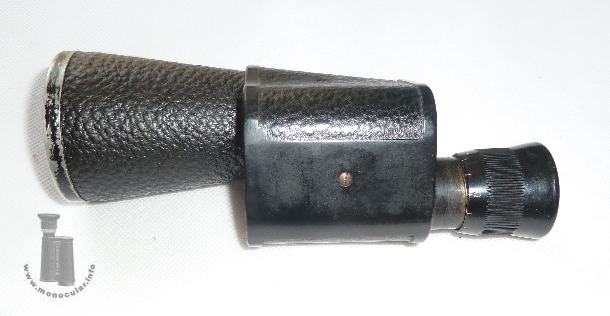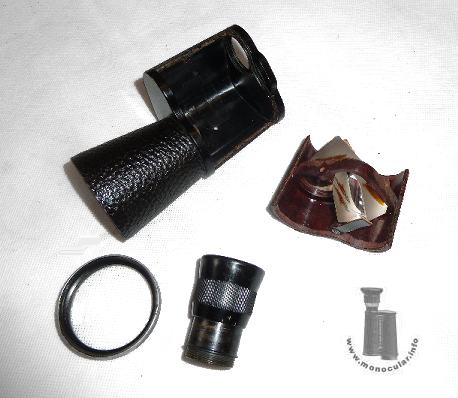Bastert 11x45
| Das hier gezeigte Monokularmodell ist mit "Bastert Bad Nauheim" in einem gelb-goldenen Linsenloge beschriftet. Es gibt keine optischen Angabe, jedoch ist die Objektivlinse 45mm und die errechnete Vergrößerung 11x. Das Besondere an dem Glas ist, dass das Prismengehäuse und dessen Deckel bzw. Wand sowie die 3/3 Augenmuschel aus Bakelit gefertigt sind. Außerdem lässt sich nach Lösen der beiden seitlichen Gehäuseschrauben ein Gehäusewandteil mit dem Porro-1-Prisemnstuhl herausziehen. Dies ermöglicht ein schnelelres Reinigen oder Austauschen der Prismen innen. Das Gehäuse hat bis auf eine rechteckige Stelle einen braunen Hartgummiüberzug. Auch der konische Aluminium-Tubus ist dementsprechend ummantelt. Die Dioptrienskala reicht von plus bis minus 3 ist aber lediglich mit Null und + sowie - beschriftet. Die Trageriemnenöse wird durch einen überstehenden Teil des oberen Deckels gebildet (vgl. einige britische Gkäser). Über die Firma Bastert in Bad Nauheim liegen keine Informationen vor. Die Otik ist unvergütet, so dass das Monokular eventuell bereits eine Produktion vor dem 2. Weltkrieg darstellt. Im Internet lässt sich als einziges Vergleichsstück ein "Bastert Nauheim Max Lux 6 X 30" Fernglas finden. |
The monocular depicted here is marked "Bastert Bad Nauheim" with in a yellowish-golden lens logo. There are no optical data, but the objective lens is 45mm in diameter which lets calculate the magnification as being 11x. The special feature of this glass is that the prism hosuing and its cover plates as well as the 3/3 eyecup are made of Bakelite. Moreover, when losening the two screws on the body sides, you can pull out a part of the hosuing wall with the prism cahir carrying Porro I prisms.. This allows cleanign and subsituting the prisms isnide easily. The prism housing has abrown Ebonite covering aprt from one plain brwon Bakelite part. The conical aluminium tube is also covered with Ebonite. The dioptre scale ranges from plus to minus three, only being marked with zero + and -, though. The strapl ug is formed by an protruding part of the top cover plate (cf. some british models) There are no information available on the company Bastert in Bad Nauheim. The optics are uncoated. So, it may be a pre-WWUU prodcution. There is only one reference model retrievable on the inernet: a "Bastert Nauheim Max Lux 6 X 30" binoculars. |



| Das Bastert-Monokular ist 158-168 lang und wiegt 277g. Der konische Tubus verbreitert sich von 40 auf 53 mm im Durchmesser. Das Okualrstück ist 26mm, der Fokussierungsteil 31mm und die Augenmuschel 34mm im Durchmesser. Das Gehäuse misst oben 55x55mm und unten 58x58mm. | The Bastert monocular is 158-168 long and weighs 277g. The conical tube increases from 40 to 53 mm in diameter. The eyepeice is 26mm, the focusing part 31mm, and the eyecup 34mm in diameter. The hosuing measures 55x55mm at its top and 58x58mm at its bottom. |


Fotos: Zeun

